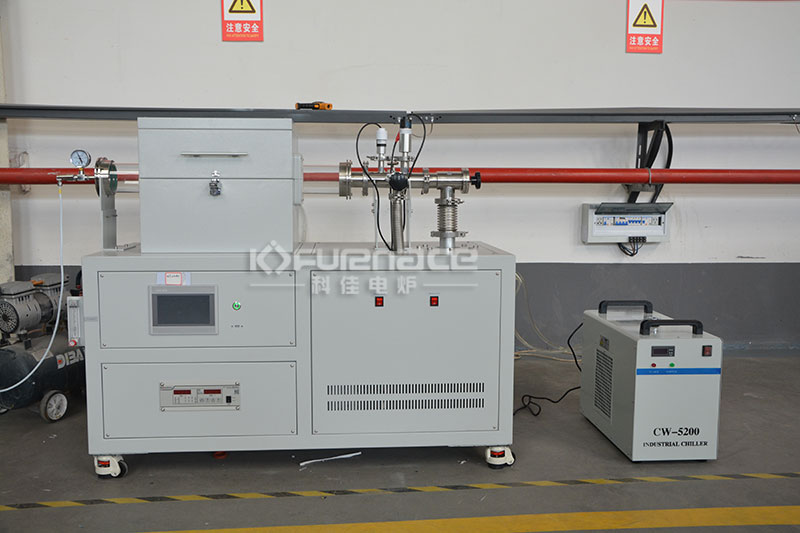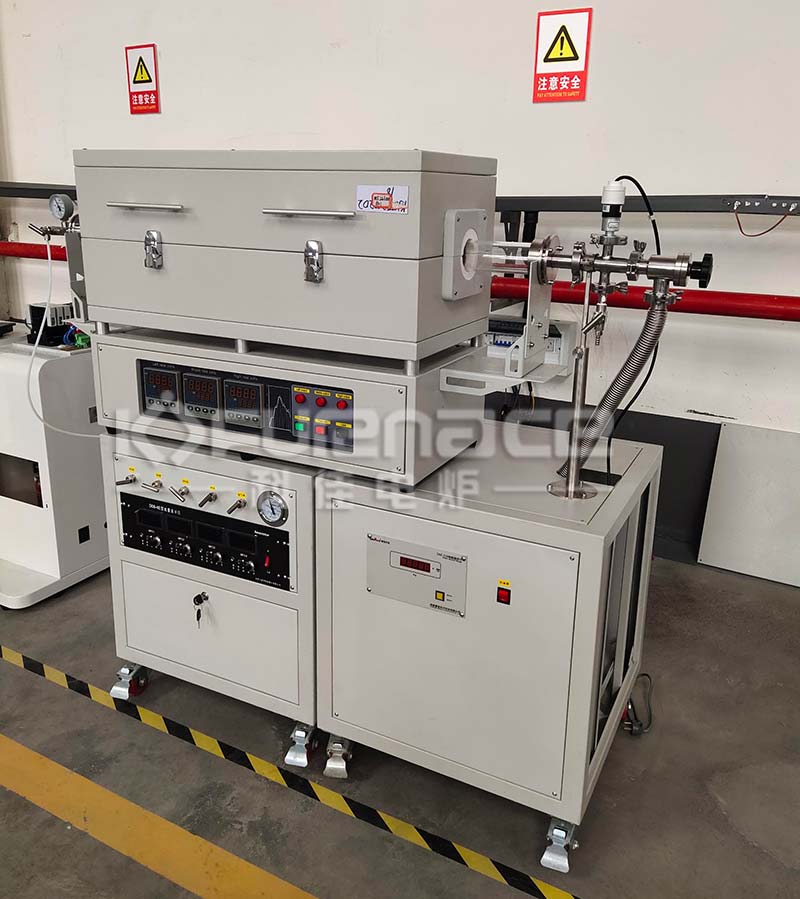The experimental tubular CVD electric furnace has shown outstanding performance in material preparation and thin film deposition, with core advantages such as high temperature performance, precise temperature control, gas management, efficient deposition, wide applicability, and stability and reliability. It is a commonly used heat treatment coating equipment in the fields of materials science and engineering. Let’s take a detailed look below!

A commonly used experimental tubular CVD electric furnace (click on the image to view product details)
1. Performance characteristics: Dual guarantee of high temperature and precise temperature control
High temperature performance: The heating temperature of the tubular CVD electric furnace used in experiments can reach up to 1600 ℃ or even higher (such as some equipment reaching 1800 ℃), which can meet various experimental and process requirements with strict requirements for high temperature. For example, in experiments such as silicon carbide coating and ceramic substrate conductivity testing, high temperature environment is the key to ensuring material properties.
Precise temperature control: Equipped with a precise temperature controller, it can achieve precise temperature control. The temperature control accuracy of Kejia electric furnace can reach ± 1 ℃, ensuring the accuracy and stability of the experiment. This is important for CVD experiments that require strict control of reaction conditions, such as the deposition of carbon materials such as graphene, where temperature fluctuations may directly affect the quality of the film.
Uniform heating: The internal design is reasonable to ensure uniform temperature distribution inside the furnace, which is beneficial for improving experimental results and product quality. A uniform temperature field can avoid uneven material properties caused by local overheating or undercooling.
2. Application areas: Materials preparation tools for multiple fields
Thin film deposition: capable of preparing high-quality, large-area thin films, such as metal thin films, semiconductor thin films, optical thin films, etc. These thin films have wide applications in industries such as electronics, semiconductors, optics, etc., such as solar cell materials, fiber optic coatings, etc.
Nanomaterial preparation: By adjusting reaction conditions and substrate materials, nanomaterials with different morphologies and sizes can be synthesized, such as nanoparticles, nanowires, etc. These materials have broad application prospects in fields such as nanoelectronics and nanomedicine.
Ceramic sintering and powder metallurgy: can be used for powder roasting and sintering of ceramic materials, as well as forming metal or ceramic materials through gas-phase reactions, providing new preparation methods for the field of powder metallurgy.
High temperature experiment and atmosphere control: As an experimental equipment, it can be used for various research experiments such as high-temperature atmosphere sintering, atmosphere reduction, vacuum annealing, etc., to meet the research needs of materials science and engineering fields.
3. Structural design: a bidirectional combination of high efficiency, energy saving, and stable operation
Furnace material: High efficiency and energy-saving materials such as ceramic fibers or polycrystalline alumina fibers are used to improve energy utilization efficiency, while reducing the temperature of the furnace shell and ensuring operational safety.
Furnace tube and sealing: Furnace tubes are often made of high-purity materials (such as high-purity quartz tubes or corundum tubes), and both ends are sealed with stainless steel high vacuum flanges to ensure airtightness and high temperature resistance. This helps maintain a vacuum environment or specific atmosphere during the reaction process, improving the accuracy of the experiment.
Double layer furnace shell and fan: Adopting a double-layer furnace shell structure, a fan is installed between the double-layer furnace shells to achieve rapid temperature rise and fall, while reducing the surface temperature of the furnace shell and improving operational convenience.
4. Convenience of Operation: Design Concept of Intelligence and Humanization
Program temperature control system: It can edit multiple program temperature controls to meet the temperature requirements of different experimental stages and improve experimental efficiency.
Gas flow control system: equipped with convenient gas flow control systems (such as manual float flow meters or high-precision mass flow meters) to meet the process requirements of different protective atmospheres and ensure the accuracy of experiments.
Sliding rail design and universal wheels: The furnace bottom can adopt a sliding rail design, and the furnace body can be manually moved left and right to expose the furnace tube to room temperature and achieve a rapid cooling rate; The furnace body is equipped with four universal wheels, which facilitate overall movement and improve the flexibility of experimental operations.
5. Security Performance: Comprehensive Security Protection System
Overtemperature alarm and leakage protection: Equipped with overtemperature alarm and leakage protection functions, it prevents safety accidents caused by high temperature or electrical faults.
Explosion proof design: For experiments involving flammable and explosive gases, choose explosion-proof equipment and equip it with gas leak detection devices to ensure experimental safety.
Airtightness guarantee: The combination of high-purity material furnace tube and stainless steel high vacuum flange sealing ensures airtightness during the reaction process, avoiding harmful gas leakage and causing harm to operators and the environment.
6. Cost and Maintenance: Economy and Convenience of Long term Operation
Initial procurement cost: The price is affected by factors such as temperature limit, atmosphere control, heating elements, etc. Although the initial procurement cost of high-end equipment is relatively high, its efficient performance and wide range of application areas can bring long-term economic benefits to users.
Long term operating costs: Efficient and energy-saving furnace materials and precise gas flow control systems can reduce energy consumption and consumable costs; High quality heating elements (such as silicon carbide) have a lifespan of over 5000 hours, reducing replacement costs.
Maintenance convenience: Modular designed equipment can quickly disassemble vulnerable parts such as furnace tubes, reducing maintenance time; Equipped with automatic cleaning functions (such as high-temperature self-cleaning programs) can reduce the impact of residues on equipment lifespan.

Multi temperature zone tubular CVD electric furnace (click on the image to view product details)
Overall, as a commonly used coating equipment in university laboratories and industrial and mining enterprise laboratories, the tubular CVD electric furnace has numerous advantages. Before selecting, it is necessary to communicate the parameters with relevant technical personnel in order to select the tubular CVD electric furnace that is more suitable for one’s own experiment!Click to learn more CVD devices! Or click on online customer service to learn more about product information!